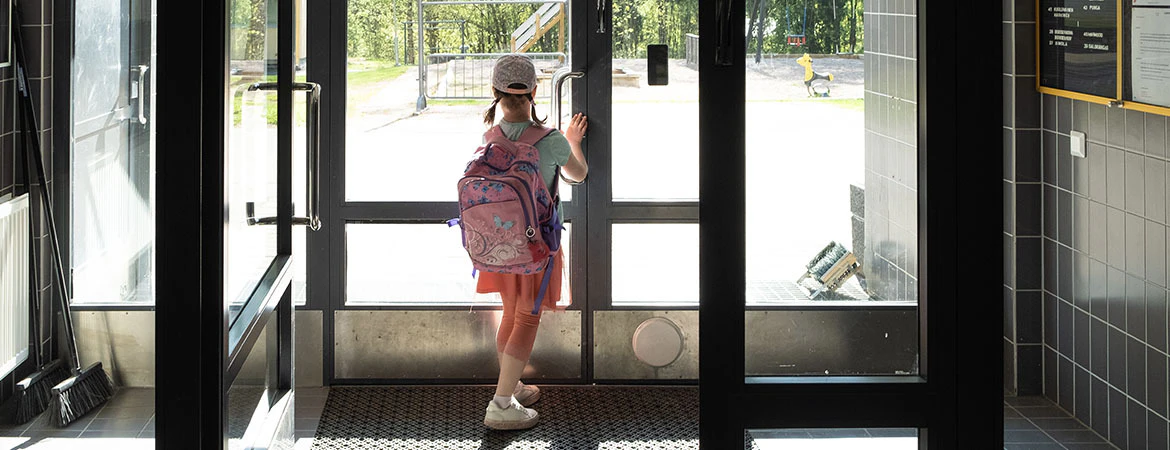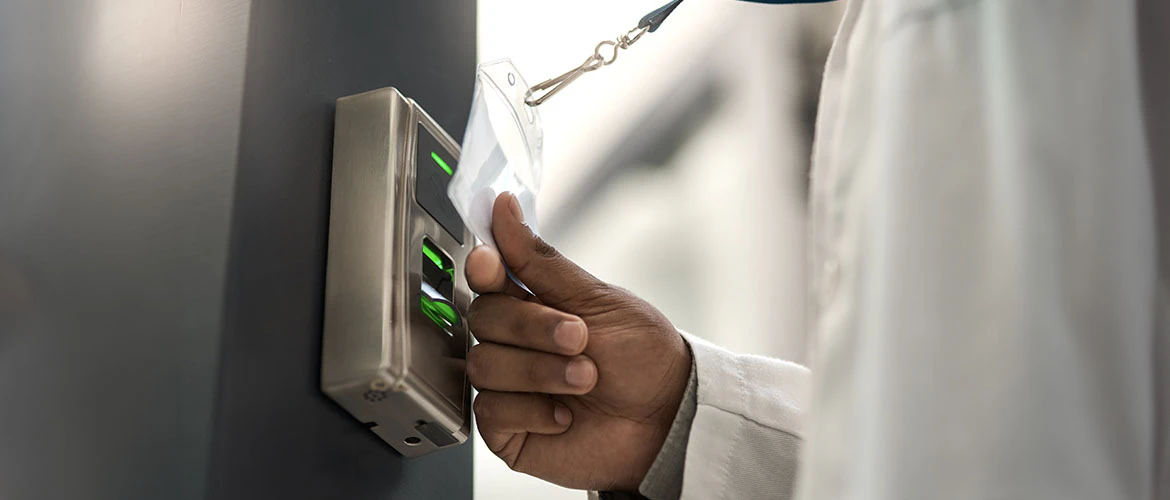Trusted by 100,000+ organizations across the globe
Most educators will agree that all school campuses, college campuses and educational facilities should be focused on one thing: providing the necessary tools and environments required for their students to excel. To achieve this, safety and security should be a number one priority.
Developing, maintaining and operating a comprehensive school security solution is by no means an easy task, with a wide range of technologies and procedures that must be appropriately considered. School security systems include video security, door alarms, access control systems and cybersecurity programs, with each element requiring intelligent integration to ensure the highest degree of security.
Schools across the US have been taking steps to improve their campus security systems in recent years, with 97% of those surveyed introducing measures such as locked or monitored doors and 98% implementing visitor management procedures.
This guide aims to explain all the key components required to build comprehensive security systems for schools, including how each technology works and how to integrate individual elements for proactive, holistic management. With this information, you can develop an intelligent school security system to help educators provide a safe and secure campus.
What are school security systems?
Modern commercial security systems for schools, school buildings and school grounds often consist of several different technologies designed to monitor, alert and protect students and staff from intruders or other potential dangers. The most common campus security systems include video security networks and access control systems, of which around 91% and 97% of all US public schools currently make use of in some capacity.
As schools and higher education facilities continue to provide more remote learning options and an increasing volume of digital learning resources, campus security teams are also tasked with developing robust cybersecurity programs to protect sensitive and personal data from online threats.
Further school security solutions include automated alarm systems designed to alert students and faculty to the presence of unauthorized individuals, potential fires and natural disasters, as well as smart locks, lockdown procedures and visitor management functions such as RFID-enabled ID cards and metal detectors.
While these measures are all capable of facilitating a much safer and more secure learning environment individually, developing an integrated school security system in which each component is able to communicate with the next can help campus security staff to better manage incident responses and wider safety protocols.
School door security systems and entry point management

School door security alarms
One key factor of a reliable school security system is the presence of a sensor alarm for door access. By ensuring that crucial school security checkpoints are equipped with a method of monitoring and alerting security teams to unauthorized entry attempts, valuable time can be saved in engaging wider security elements such as automated locks and secure lockdown functions. These checkpoints include any key entry points to the premises, as well as more sensitive areas within the school, such as doors to labs or equipment storage.
The best door sensor alarm for schools will feature some form of motion detection that can be configured to trigger an alarm when activated during non-operational hours. It can also be integrated into wider school alarm systems to alert security staff and admins remotely of a potential intruder.
By connecting a security alarm for door access to a cloud-based security network, admins can initiate lockdown functions and view live security footage remotely as soon as an alarm is triggered, allowing staff to react accordingly to the situation and contact relevant authorities as soon as possible.
Perimeter security alarms
Combining school door security systems with an additional network of perimeter alarms can help campus security staff to develop an even more effective early warning system. Perimeter alarms can be used to trigger the internal school alarm system, helping to both warn those inside the building of an intrusion event, and make the intruder aware that their presence has been detected.
A perimeter security alarm system can be configured to produce both audible and visual alerts to startle trespassers, and be integrated in such a way that relevant authorities are contacted once the sensors are triggered, helping to protect the school and its contents during evenings and weekends.
Access control for campus security systems
Access control solutions are keyless entry systems designed to secure indoor and outdoor environments from unauthorized individuals. There are many different varieties of access control, from simple keypad-based devices to complex biometric scanners, allowing security teams to develop dedicated school door security systems that suit a variety of needs depending on the location, risk factor and number of users for each entry.
Keypad systems, for example, are well-suited to perimeter gates and parking lots as they’re easy to operate and only require a simple numerical code, while mobile access, RFID fob and biometric-based systems can provide a more advanced level of security to internal doors and entry points.
For even greater security, control and flexibility over access permissions, a cloud-based system is the ideal solution. With a cloud school security system, it is possible to issue and revoke credentials instantly, making check-in for vendors, temporary staff and visitors much easier. It also ensures that when staff members no longer work at the school, their access rights can be revoked without the risk of passes or fobs going missing — particularly if employees’ passes are encrypted on their mobile devices.
Cloud options offer greater flexibility for faculty members who might not be at school five days a week. For example, even if a staff member was not on the premises, they could still receive real-time alerts on access activity, and monitor entry and exit points from their desktop, wherever they are working. Some cloud-based platforms also support remote school lockdown procedure activation from authorized devices.
Cloud-based school security systems are also simpler to integrate with many other cloud-based solutions. Cloud-to-cloud integrations allows educators and faculty staff to get an integrated, holistic view of everything on site.
Visitor access management

Considering the number of parents, substitute teachers, guest lecturers and contract workers that frequently require access to educational facilities, a comprehensive visitor management system is essential to ensuring that only authorized individuals are able to enter certain areas of the campus.
It’s important that school security systems include a method for both recording visitors to the campus, as well as giving them the access they need. Instead of pen and paper logs, it’s recommended that schools use a digital visitor platform to gather necessary information, such as names, check-in and check-out times, identification and the reason for their visit, for proper auditing and record-keeping.
However, these systems work more efficiently when they are integrated into a larger school security solution that provides a holistic view of entry and exit activity. Modern access methods, such as monitored visitor cards, one-time PIN codes and temporary mobile credentials, are a great way to facilitate secure visitor access for campus security in K‑12 schools and university settings.
A cloud-managed access control platform can automatically issue credentials for approved guests, generate visitor entry activity reports, send alerts and make it easier to control visitors’ access level permissions. Some systems may have built-in visitor management capabilities, such as intercom technology or guest pass features. If using standalone visitor management for school security, make sure it can integrate with pre-existing systems.
Interior school security door locks
Choosing a reliable and secure series of door locks perhaps represents the most integral aspect of an effective school lockdown procedure, so it’s incredibly important that this element is not overlooked.
An ideal school security door lock will:
Allow staff to control the locking mechanism from inside the classroom without needing to open the door.
Be accessible to all students and faculty including those with disabilities.
Require no additional training to operate.
Allow emergency responders to enter the classroom without personal access credentials.
Be compliant with the state’s building regulations and fire codes.
This is another situation in which cloud-based access control can provide several unique benefits, as the locking mechanism can be controlled using authorized mobile devices, preventing intruders from entering whilst still allowing security teams to grant remote access to emergency responders.
Exterior door locks for schools
Exterior door lock security systems for schools require a slightly different approach, as unlike interior entrances, these entry points must be accessible to a larger number of people. This includes visitors, parents, temporary guests, students and faculty members who, in compliance with building regulations and fire codes, must have unimpeded egress in the event of an evacuation.
Access control systems offering keyless entry are still permitted for use with exterior doors, provided they can be easily controlled during a school lockdown procedure, though some school districts will require the installation of emergency push bars used to quickly unlock doors from the inside during evacuations.
What to look for in a school sensor alarm for door access

If a potential intruder attempts to breach a door or window, what began as a case of trespassing now has the potential to become a much more serious situation, so ensuring that each access point is equipped with a suitable sensor alarm is paramount to the efficacy of the entire security system.
Alongside security cameras like 360-degree security cameras, door sensor alarms can be used as a primary trigger for the activation of a wider integrated security network, so it’s important to choose an appropriate device.
Door-open alarms — These devices contain two components, a magnetic strip attached to the door panel and an input sensor attached to the door frame. When the contact between each of these components is interrupted, the door alarm sensor will generate an audible warning signal. Door-open alarms are particularly useful during school lockdown procedures, as security staff will be alerted to the presence of any entry points that are being held ajar or obstructed in any way.
Door-forced-open alarms — These sensor alarms are triggered when a door is opened by force. Depending on the configuration, this can include forcing an access controlled door open that usually requires credentials to unlock, or otherwise physically activating a contact switch in the door frame. These door sensors should be integrated alongside security cameras, auditory alarms and other automated lockdown functions like shutters and deadbolts to help improve incident response times. If possible, using a cloud-based network is a great way to grant security staff the ability to monitor incidents and control doors remotely.
Video security systems in schools
While school alarm systems, access control networks and security door locks represent essential preventative and defensive mechanisms to protect schools against intruders and other potential dangers, a truly effective school security system will also make use of video security technology.
School security cameras can be installed to cover incident-prone areas, entrances and exits to provide security teams with a live view of any incidents as they unfold. Areas that may benefit from additional visibility include computer and science labs, faculty offices and teacher’s lounges, server rooms, cafeterias and storage areas. Footage from these school security systems are also helpful in providing recorded evidence of any incidents that can then be handed over to relevant authorities if necessary.
The most effective school CCTV networks will include video management software, used to store and view footage. Open-platform video hardware can also communicate with the wider school security system, allowing for automated recording in response to triggered alarms and remote viewing capabilities for admins.
Common security camera models include panoramic, pan-tilt-zoom (PTZ), dome or bullet cameras. Each camera type has its advantages, depending on the nature of the area being monitored. For example, a spacious outdoor area with variable light conditions requires a different camera to an interior hallway with consistent, bright lighting.

Protect your students, faculty and premises
Versatile, customizable camera solutions for your school or campus
Compliant with US and international regulations
Open-platform and ONVIF-conformant to work with any VMS
Trusted by educational administrators globally for quality and cost
Integrated security and alarm systems for schools
For all the benefits that the individual components of a school security system can bring, the integration of these elements as part of a wider security network provides security teams with a much more robust, versatile and effective defense against potential intruders and other dangers.
For example, access controlled doors linked to an internal school alarm system can trigger indoor security cameras like fixed IP cameras to record areas of interest after sensors detect unauthorized activity, such as the door being forced open. The system can also be configured to send security alerts to the necessary personnel, and give first responders access to live video of the incident, if needed.
One of the key factors in deploying an integrated school security system is choosing hardware and software that works together. Open-platform cameras, door readers, wireless locks and sensors will enable administrators to easily connect systems from different providers for combined management and reporting.
Integrated school alarm system use cases
Vaping detectors — With recent studies indicating that up to 14% of US high school students use vaping devices during school hours, many educators are looking to implement effective measures to prevent this issue. By installing vape detectors in hotspots like bathrooms, and integrating these sensors alongside existing alarms, staff can be alerted to vaping incidents as and when they occur. These sensors can help security teams spot and triage incidents in areas where installing security cameras is prohibited by law.
Property theft — If a school has a recurring issue with property theft, such as bikes being stolen or cars being broken into, security cameras can be positioned facing the area of interest and integrated with on-site alarms to immediately alert staff of any ongoing incidents.
How cyber and physical school security solutions work in unison
With around 33% of the largest school districts in the US planning to continue providing remote learning programs, and an increased reliance on digital record keeping, it’s quite alarming that as many as 30% of K‑12 districts aren’t currently implementing cloud security measures for their schools.
The range of potential cyber threats that schools must consider include data breaches, social engineering, ransomware and phishing attacks.
Though the specifics can vary, there are a few best practices all schools should follow to reduce risk and keep records secure:
Encrypt all information sent between devices connected to the school’s network. Store all data within school networks on a secure server, with backups stored in accordance with government regulations.
Schedule regular cybersecurity network tests with IT professionals to test for vulnerabilities.
Limit access to confidential data and establish firewalls to protect against unauthorized activities.
Secure IT departments, server rooms, computer labs and private offices with access control.
Have IT staff and security teams work together to develop defense and incident response protocols.
Facilitate regular cybersecurity training for all staff and communicate best practices to students where appropriate.
School campus and security system management platforms
The focal point of an effective integrated security system for schools should come in the form of a centralized management platform, where security and IT teams can work together to perform regular maintenance, configure individual component settings and manage the overall scaling of the school alarm systems, access control and campus-wide video security networks.
With the controls for each system integrated into one easily navigated platform, teams are able to reduce workloads, improve productivity and ensure that their entire security network is optimized to function as effectively as possible.
School security companies also exist as a management option for facilities that don’t have adequate in-house departments able to cover these responsibilities. These companies can be hired to work alongside the security and IT staff that are part of the school’s faculty to help develop and maintain effective integrated security networks without placing additional strains on existing staff members.

With each element of a comprehensive school security system now covered in detail, use this campus security checklist to help design an effective and reliable series of school security solutions for your facilities.
School alarm systems
Install dedicated interior and exterior alarms in compliance with local building codes.
Integrate alarm systems with additional security features such as access control.
Consider the size of the school and locate specific points of weakness.
Consider additional alarms for school settings, such as vape detectors and motion sensors.
School access control devices
Consider which systems suit specific use cases; keypad access may be better suited to parking lots or faculty-only areas, or a full mobile access system may be the best choice for securing the entire campus.
Look into how access control components can be integrated with existing security features, and where management can be streamlined.
Install access controlled doors in areas that can be used as school security checkpoints, such as reception areas, auditoriums, gymnasiums, laboratories or staff areas.
Establish security protocols and systems for visitor management, including maintaining up-to-date watch lists and visitor records.
Check for automated lockdown functions and remote locking capabilities for use in emergencies.
School security cameras
Identify areas of interest including entrances, exits and private or secure locations for school security camera systems.
Consider which style of surveillance cameras — such as pan-tilt-zoom security cameras and 360-degree security cameras — are most appropriate for the location and required task.
Check that the camera network can be integrated with the school’s video management software, access control, security alarms and other additional components.
Work with an experienced camera installer to ensure security cameras are properly installed and configured.
With these considerations in mind, school security staff, school administrators and IT teams are able to develop personalized and reliable school security measures designed to keep students and faculty safe. By utilizing integrated management tools and cloud-based platforms, a comprehensive school security system for K‑12 schools, colleges and universities can be maintained with relative ease, creating a safe and secure environment for all.
Have questions? We can help
Our video security experts can help you implement the right security system for your business.







